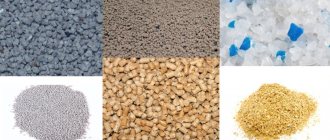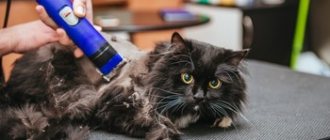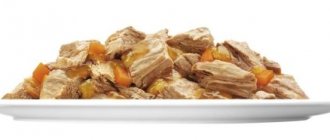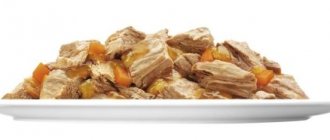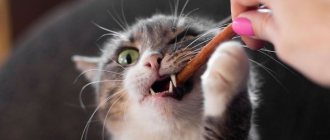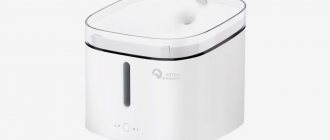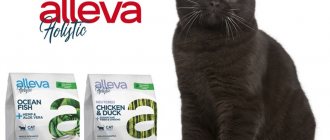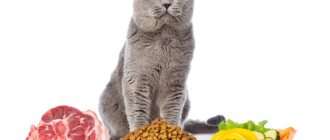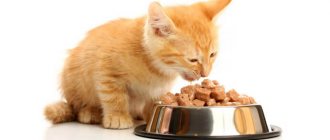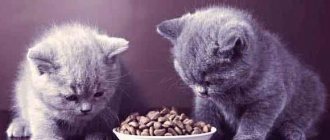Castration, with today's level of veterinary medicine,
has a very low risk for healthy young animals (death after surgery occurs in less than 1 in 500 cats) and protects against possible offspring, animal aggression, and unwanted odors in the apartment.
However, after castration, the animal has a risk of developing health problems, such as obesity, urolithiasis, and difficulties in the functioning of the cardiovascular system. That is why a neutered cat needs to choose a balanced diet. Let's figure out whether it is possible to feed him regular food.
In the article, we looked at dry and wet food, made a rating of the economy, premium, super premium, and holistic classes, and found out whether it is necessary to feed the cat with special food.
Brief feed table
Table to jump to a specific food review at the end of the article.
| Name of food | Type of taste | Basic taste | Price for 1 kg |
| Pro Plan Sterilized ↓ | Cold cuts | Turkey | 513 RUR To the store |
| Hill's Science Plan ↓ | Cold cuts | Chicken | 556 rubles To the store |
| Purina One “Sterilized” ↓ | Cold cuts | Beef | 343 rubles To the store |
| Royal Canin “Sterilized 37” ↓ | Meat and vegetable platter | Chicken | 524 RUR To the store |
| 1st Choice Sterilized↓ | Cold cuts | Chicken | 640 rubles To the store |
| Bosch Sanabelle “Sterilized” ↓ | Cold cuts | Poultry meat | 845 RUR To the store |
| Eukanuba Sterilized ↓ | Cold cuts | Chicken | 586 RUR To the store |
| Go! ↓ | Meat and fish platter | Turkey | 619 RUR To the store |
| Acana Regionals Wild Prairie ↓ | Meat and fish platter | Chicken | 648 RUR To the store |
| Orijien Fit & Trim ↓ | Meat and fish platter | Chicken | 757 RUR To the store |
The calculation of prices per 1 kg was based on packages weighing 2-4 kg. For packages weighing 10 kg, the cost of each kilogram may be more profitable.
Where is Royal Canin made?
The main enterprises are located in France, one of the subsidiary plants is in the Moscow region (Russia). Russian biscuits and canned food from Royal Canin for sterilized cats are considered to be of lower quality, since the requirements for their production in the country are lower than in the European Union, so owners prefer to feed their pets with French canned food.
Royal Canin is the most popular brand on the market
For your information! The remaining enterprises are located in different countries, but their products are not imported to the Russian Federation. The products are manufactured by Brazilian, Argentine, Canadian, American, South African and British factories.
What can you feed a neutered cat?
It is not at all necessary to feed your cat with store-bought food after castration, however, if you decide to give your pet natural food, then it is important to balance it with the necessary vitamins and minerals.
- Porridge. Rice, corn, wheat and oatmeal are suitable. If the cat turns his nose, you can add a little lean meat during cooking.
- Lean meat. You can give dietary meat like chicken, rabbit or turkey. Unlike porridge, the cat will definitely eat it with pleasure.
- Wet food or canned food. Preferably specialized ones marked “for neutered cats.”
- Specially grown grass. In pet stores you can often see small containers with sprouted seeds of oats, barley or wheat. Even on the street, stray cats often chew grass. It helps digest food and is very beneficial for the cat. You can grow it yourself by buying seeds at the market.
- Water. As with all living organisms, water is the key to health for a cat. Sufficient consumption of it will relieve dehydration and related problems. It is especially important to monitor how much your cat drinks if you feed him dry food. You can also give your pet meat broth.
The essence of sterilization and the changes that occur in the cat’s body after it
Globally, sterilization is the only humane way to reduce the number of stray animals. This method does not require killing living creatures, which is why many organizations dedicated to their protection promote the need for sterilization. If the cat is not intended to be used for breeding, then it is better to sterilize it. This will avoid many problems associated with the animal’s need to realize the instinct of procreation. The operation will also prevent the birth of unwanted offspring, which may later end up on the street.
Currently, veterinarians have developed a sterilization technique in detail, so it does not pose a particular threat to the health of the animal, and possible risks are minimized. Before surgery, the cat must be examined, a suitable anesthesia must be selected, and possible contraindications must be excluded. The operation can be performed at any age, but it is recommended to do it on a young cat.
The best option is before the first signs of sexual desire appear. As a rule, maturation occurs at 7-8 months, so it is recommended to sterilize the animal at about six months of age. In addition, a young and healthy body will more easily tolerate anesthesia and the subsequent restructuring of the body after the operation.
Sterilization operations today are most often performed laparoscopically. Through a small incision, the surgeon removes the ovaries and ties the tubes. This method is the most gentle: the consequences are minimal, the operation does not require long and strong anesthesia. Removal of the ovaries and ligation of the fallopian tubes is recommended for young nulliparous individuals. Complete removal of the organs of the reproductive system (uterus, tubes and ovaries) is recommended for adult cats that have already given birth.
The ovaries are part of not only the reproductive system, but also the endocrine system. These organs produce sex hormones that are responsible for the instinct of procreation in the animal. After their removal, a significant restructuring of the hormonal levels occurs.
Physiologically, this is manifested by the following changes:
- metabolic processes slow down, so after sterilization you should carefully monitor your cat’s diet and physical activity;
- Energy needs are reduced (by about 25%), but appetite, on the contrary, increases, which is due to a decrease in the level of stress (it accompanies the excited state of the cat when it wants to realize its instinct for procreation);
- the process of formation and separation of urine slows down, the number of urinations decreases, which can lead to the accumulation of salts and the formation of stones in the organs of the urinary system.
After sterilization, the cat's diet should be as usual: if it was fed ready-made food, then it is necessary to continue to do so, choosing products designed specifically for sterilized cats. If the cat received natural food, then you should feed it such food, excluding potentially harmful products.
You can change eating habits only if absolutely necessary, as this is a serious stress for the animal.
What not to give
Although, according to popular belief, cats adore milk and fish, the latter should absolutely not be included in the animal’s diet menu. If milk will most likely only give you an unpleasant surprise in the tray, then fish contains a lot of phosphorus, which negatively affects the condition of the kidneys and bladder. It is from its increased amount in the body that urolithiasis is acquired.
Praised sausages should also be excluded from the diet, especially salted and smoked ones.
Professional opinion about Brit Care Sterilized
How are the good results achieved, which animal owners often write about: prevention of tartar, shiny coat, activity of the animal?
Experts recommend Brit food for sterilized cats. Reviews from veterinarians note the correct combination of fats (12%), proteins (36%) and natural fiber (5%). This ratio prevents obesity. To maintain the required urine pH, the percentage of magnesium in the diet of castrated animals is reduced. To help the kidneys and urinary tract work better, it contains sea buckthorn extract.
Why not Whiskas and Kiteket?
The main reason why you should give up popular economy feeds like Whiskas is their composition. The diet of a neutered cat must be prepared wisely, because such a pet has an increased risk of developing obesity and urolithiasis.
Let's compare the composition of the 2 foods to understand why you shouldn't skimp on your cat's nutrition. For comparison, we took food specialized for feeding sterilized cats and cats of economy and premium classes.
- Whiskas for sterilized cats with chicken.
Whiskas feed composition
- In first place, wheat flour is a source of cheap carbohydrates. Often causes food allergies in cats and leads to excess weight gain. Grains, in general, are not a typical food for cats, so they can cause digestive problems.
- Chicken flour - the manufacturer saves on the source of animal proteins by not using fresh or freeze-dried meat. The protein in the food is more of plant origin, but cats are predators, not herbivores.
- Rice is another source of carbohydrates. As we can see, there are more sources of carbohydrates in Whiskas than proteins.
- Animal fats and vegetable oil are sources of fat in food of unknown origin. It is unknown what kind of fat and oils from which plants are added to the feed.
- Chicken and pork liver are good ingredients, but they are the lowest in the composition, which means their percentage in the feed is negligible.
- Brewer's yeast is a source of B vitamins.
- Vitamins and minerals – as with fats, it is not known which vitamins the manufacturer added.
Bottom line! Whiskas is a carbohydrate food with undisclosed sources of many components. The low content of animal protein makes this food unsuitable for daily feeding of cats.
- 1st Choice Sterilized.
- Sources of animal protein : chicken meal, fresh chicken, liver hydrolysate. It’s good that chicken is in 1st and 2nd place in the food composition. This means that there is more animal protein in Fest Choice than carbohydrates.
- Vegetable protein sources: rice protein and lentils. Vegetable protein is presented with grain-free components, which reduces the risk of allergies. Rice protein is digested better than wheat protein, and it is also free of starch. And lentils, like any legume, are known for their high protein content.
- Carbohydrates and fiber : sweet potatoes, tapioca, pea fiber. Pea fiber, in moderation, normalizes digestion.
- Sources of fats:
flaxseed, chicken fat, sunflower oil extract. Good sources of Omega 3 and 6. - Salt is a controversial product that may be added as a source of minerals. May make cats thirsty after eating, so water should always be available.
- Vitamins - a list of all additives is indicated in the composition and is not hidden by the manufacturer, although their percentage is unknown. It’s good that it contains taurine, a vital vitamin for cats.
- Natural Additives : Yucca Schidigera, rosemary, dried alfalfa, pineapple, ginger, mint, parsley and green tea. All these components are at the bottom of the list and are needed to improve the taste and smell of the food.
Bottom line! 1st Choice is a super-premium food with a good content of animal protein. Quality sources of carbohydrates, fiber and fats. Open list of vitamins and minerals. The absence of grains and starchy foods will prevent your pet from gaining excess weight.
Veterinarians' opinion
Evgeniy, 49 years old, Samara.
Before choosing food, I always advise having the animal’s urine tested. At a neutral pH level (6-6.5), universal, complete, super-premium canned food is suitable. If the urine is alkaline, it is better to feed the animal dry or wet food specifically for castrates.
Alina, 34 years old, Voronezh.
If castrates eat complete canned food (not necessarily special), the risk of developing urolithiasis is reduced. I recommend diluting wet food with water (10-20 ml) for cats and cats who don't drink enough. This increases moisture consumption.
Mikhail, 52 years old, Irkutsk.
Cats and cats get used to the type of food chosen by their owner. I recommend combining dry and wet food. For example, you can give dry food in the morning and lunchtime, and wet food in the evening. However, this must be done on an ongoing basis so as not to provoke problems with the stomach and intestines.
All information posted on the site is provided in accordance with the User Agreement and is not a direct instruction to action. We strongly recommend that before using any product, you must obtain a face-to-face consultation at an accredited veterinary clinic.
Special food or natural products?
The cat is not able to feed himself in the apartment. If on the street he can find food for himself, for example, catch some kind of mouse, then in the house the decision on what food to feed entirely belongs to the owner.
There are only two possible types of cat food: natural food and ready-made store-bought food. Let's take a closer look at both options and decide which one is best suited for a neutered pet.
1. “Natural nutrition” . The expression is put in quotation marks for a reason, because real natural food for a cat is a caught mouse or bird + a small addition of cereals. There will probably be a very tiny number of cat owners who will want to feed their Vaska live mice right in their apartment.
This type of food, which has its own rules of preparation, is only as close as possible in its composition and balance to natural nutrition in nature.
Pros of “natural nutrition”:
- No dyes, preservatives or flavors in the composition.
- Large percentage of meat and meat by-products.
- You can adjust your pet’s diet yourself.
- A large percentage of moisture in the finished food (no need to worry too much about how much water your pet drinks).
Disadvantages of straight women:
- High cost.
- It takes a lot of time to purchase and properly prepare food.
- Short shelf life of the finished product.
- It is necessary to follow the feeding regime and accustom the cat to it.
- An additional complex of minerals and vitamins is required, which is difficult to choose on your own.
- Without the necessary knowledge, it is difficult to create a properly balanced diet (food for neutered cats must be prepared with even greater care).
2. Store-bought feed. You can pay attention to specialized food for neutered cats. A distinctive feature is the reduced content of phosphorus and magnesium, as well as reduced nutritional value, due to which the animal does not gain weight and remains in good physical shape.
There are two alternatives - dry food (“drying”) or wet food in the form of canned food and spiders.
Dry food. Beginners believe that it is the consumption of dry food that leads to problems with the pet’s health, but this is only true in relation to economy class (Whiskas, Kitekat), they contain a lot of thickeners and preservatives, and no more than 5% meat. Companies spend a lot of money on advertising the product rather than on good ingredients.
The next category is premium food. The food contains more meat and fewer harmful additives, which only slightly improves it compared to economy class. However, there are also higher quality foods (which is reflected in the price), belonging to the super premium and holistic , which will only improve the cat’s well-being and will not lead to diseases associated with poor nutrition.
Pros of “drying”:
- Cheaper than “natural food”.
- Does not require time to prepare.
- Enriched with vitamin complexes.
- The diet is balanced by the manufacturer.
- A wide range of.
- Availability of specialized food for neutered cats.
Minuses:
- Contains little moisture. If a castrated cat drinks little water while feeding dry, this can lead to the formation of urolithiasis.
- Due to the attractiveness of the food (smell and taste), the cat may eat more than necessary and gain weight.
- Dry food is far from natural nutrition.
Advice! It is recommended to sometimes dilute the usual diet with wet food such as canned food or pouches (bags) to avoid constipation due to dry food.
Wet food. Available in the form of canned food or spider food, this type of food is usually of better quality than dry food, as it contains more meat. Some species are used only as a treat, and not as the main diet (the category is indicated on the package).
Pros of wet food:
- Contain a lot of moisture.
- There is no time spent on preparation.
- Attractive to your pet.
Negative sides:
- Very expensive.
- They do not protect against the formation of tartar.
Important! It is best, if you buy a ready-made food product, not to change the manufacturer, since a sudden change in brand may cause your pet to suffer from indigestion.
Brit Premium
Brit Care Sterilized dry food is considered by the company as a preventive food that reduces the risk of urinary tract diseases. This fact makes the price of the product slightly higher compared to analogues. Veterinarians advise purchasing such food on the recommendation of professionals, since there is no point in overpaying if the animal does not have problems. The main indicator is the pet’s regular urination.
In the Premium line, four-legged pets are offered chicken. What is the difference between dry food for sterilized cats and super premium class? Reviews indicate that the price reduction is due to the ingredients. It still contains no dyes, improvers, etc. But the proportion of grains has been slightly increased, and the composition of the chicken is divided into dried product, which is 15%, and chicken meal (17%). Veterinarians claim that this ingredient contains protein, so the food can be considered a complete diet. However, this shows some cunning of the manufacturer trying to reduce the cost of the product.
Preventing diseases with proper nutrition
Urolithiasis disease. After castration, the cat's urinary canal narrows. The risk factors for ICD are as follows: in most cases, males are affected by the disease after two years of life (according to statistics, five-year-olds are most often affected).
It is important to prevent ICD. To do this, you need to have your urine tested at least twice a year. This will help identify sand or already formed rocks, if any. The disease can go unnoticed for two years, and then surgery will not help. 80% of cases of advanced stage of ICD are fatal.
Obesity. After castration, the cat loses the desire to seek the attention of females and reproduce, so his activity decreases, therefore, he needs to consume fewer calories per day. Special feeds take this into account, so they are more nutritious and lower in calories.
The animal does not get enough of regular food for regular consumption; as a result, it eats more than it should and gains weight. The owner has to switch to dietary products to reduce the pet’s body weight, and this can cost a pretty penny.
Important to remember! Only for people can a fat, clumsy cat seem something funny. In fact, it is difficult for the animal: neither to climb anywhere nor to frolic. For prevention, you should feed your cat often, but in small portions. Under no circumstances should you be fooled by your pet’s tantrums.0
Since neutered cats are less active, they drink less liquid. Due to this, they go to the litter box less often, and the concentration of urine increases. In addition to fewer calories, the specialized food has a reduced content of carbohydrates and fats, and also helps control the acidity of urine. This is why it is important to buy food for your pet that is marked “for neutered cats.”
Professional opinion about Perfect Fit Sterile
The composition of the product is also criticized by the professional community. At the same time, experts note that the diet is balanced and will not harm a healthy pet. It is designed to support healthy digestion, vitality and optimal weight. This food for sterilized cats, reviews of which from veterinarians are quite contradictory, is suitable for those whose income does not allow them to use more expensive products. It is imperative to take into account the recommendations on feeding standards. They are designed for the weight of the cat and range from 35 to 50 g. The norm can be increased for animals over 5 kg.
Rating of the best dry food for neutered cats
Feed is divided into different quality categories (classes). Experts in this field evaluate raw materials on a five-point scale. It is better to listen to the opinion of professionals if you want your pet to please you and your family for as long as possible.
Economy class food
Cheap foods such as Whiskas, Friskies, Kitekat, Darling, Tom Cat and Perfect Fit should be completely excluded from your pet’s diet once and for all. There is no benefit from them, only harm. Poisoning with these cheap feeds is not uncommon. Due to the low cost (about 12 rubles per pouch), manufacturers do not add either natural meat or by-products to the composition. The cat eats only soy and wheat, which greatly affects his overall health.
Flavorings are added to economy-class food, due to which the animals become like drug addicts. It is extremely difficult to accustom them to another food after this.
Some owners consider it profitable to buy these cheap foods, although this is not true: due to the low nutritional value, the mouser eats three times more than he would eat good food, and because of this, food costs increase in proportion to the portions eaten.
Premium food
1. PRO PLAN
| Pro Plan Sterilized | ||
| Type | Dry food | |
| Type of taste | Cold cuts | |
| Basic taste | Turkey | |
| Consistency | Dry | |
| Weight | 1.5 kg, 3 kg | |
| Go to the store | ||
Pros:
- The Pro Plan brand is quite well known in wide circles.
- You can buy this food in almost any store, including supermarkets.
- Nestle Purina PetCare company offers a wide variety of flavors and release forms, the high rating of which affects the reputation of the product. You can also choose dietary or medicinal food for your pet.
- Good reviews from veterinarians.
Of the minuses:
- The price is quite high, but you can buy food through an intermediary (it will be a couple of hundred rubles cheaper).
- Your cat may be allergic to some foods.
2. Hill's
| Hill's Science Plan | ||
| Type | Dry food | |
| Type of taste | Cold cuts | |
| Basic taste | Chicken | |
| Consistency | Dry | |
| Weight | 300 g / 3.5 kg / 8 kg / 1.5 kg | |
| Go to the store | ||
Our website already has a detailed review of Hill's food, where we reviewed all food lines and their composition.
Pros:
- Maintained balance of all components of the composition. Because of this, separate supplementation with vitamins is not required.
- Just like PRO PLAN, you can buy it in a regular supermarket.
- Wide range of flavors and specialized foods.
- Good reviews from specialists.
Of the minuses:
- A large amount of vegetable protein and carbohydrates.
- Frequent cases of allergies in animals.
3. Purina One
It is curious that both Purina One and PRO PLAN are the brainchild of the same company.
| Purina One “Sterilized” | ||
| Type | Dry food | |
| Type of taste | Cold cuts | |
| Basic taste | Beef | |
| Consistency | Dry | |
| Weight | 750 g / 1.5 kg / 3 kg | |
| Go to the store | ||
Pros:
- Availability in any supermarket or pet store.
- A line of medicinal food for sick animals.
- Quite a large amount of meat (turkey).
Of the minuses:
- High content of wheat and corn gluten, which can harm the animal's body.
- Additives included.
- Quite mixed reviews from veterinarians and the product.
Watch a review of Pro Plan food for neutered cats in the video below:
Super premium food
1. Royal Canin
Perhaps the most popular and best super-premium food. Although, recently, Royal Canin food produced in Russia has been increasingly criticized for quality, it received such a high rating only because of the brand.
| Royal Canin “Sterilized 37” | ||
| Type | Dry food | |
| Type of taste | Meat and vegetable platter | |
| Basic taste | Chicken | |
| Consistency | Dry | |
| Weight | 0.4 kg / 2 kg / 4 kg / 10 kg | |
| Go to the store | ||
Pros:
- Relative quality of raw materials and selected components.
- A wide range of types and flavors of food (from regular to medicinal).
- A separate line of food for breeds such as Siamese, British and Persian.
- Possibility of purchase in pet stores and some supermarkets.
- Quite a low price.
Of the minuses:
- Additives, preservatives and impurities in the composition.
- Possible allergy of the pet to some ingredients.
2. 1st Choice Sterilized
Grain-free food for sterilized cats from Canada. Not a very popular brand of cat food, which owners are gradually looking at, because the composition is really good.
| 1st Choice Sterilized | ||
| Type | Dry food | |
| Type of taste | Cold cuts | |
| Basic taste | Chicken | |
| Consistency | Dry | |
| Weight | 0.32 kg / 2.4 kg / 5 kg | |
| Go to the store | ||
Pros:
- Good quality protein of animal and plant origin.
- The food is grain-free, which reduces the risk of allergies.
- The food is approved by the Canadian Veterinary Medical Association (CVMA).
- Reasonable price for super premium food.
Of the minuses:
- The brand is not very popular, which is why the food is difficult to find in pet stores.
- The line has one flavor for sterilized cats.
3. Bosch Sanabelle
Feed made in Germany.
| Bosch Sanabelle “Sterilized” | ||
| Type | Dry food | |
| Type of taste | Cold cuts, grain-free | |
| Basic taste | Poultry meat | |
| Consistency | Dry | |
| Weight | 0.4 kg / 2 kg / 10 kg | |
| Go to the store | ||
Pros:
- Sufficient amount of natural meat.
- Availability in pet stores and supermarkets (less common).
- Relatively inexpensive price.
Of the minuses:
- The composition does not always specify which antioxidants are used in preparation.
4.Eukanuba
| Eukanuba Sterilized | ||
| Type | Dry food | |
| Type of taste | Cold cuts | |
| Basic taste | Chicken | |
| Consistency | Dry | |
| Weight | 0.4 kg / 1.5 kg / 2 kg / 10 kg | |
| Go to the store | ||
Pros:
- High content of animal protein.
- A line of medicinal feeds.
- Relatively low price.
Of the minuses:
- The manufacturer does not specify how the protein is produced.
- Preservatives and additives.
Holistic class
Holistic - the best, elite cat food
1. Go Natural
| Go! | ||
| Type | Dry food | |
| Type of taste | Meat and fish platter | |
| Basic taste | Turkey | |
| Consistency | Dry | |
| Weight | 230 g / 1.81 kg / 3.63 kg / 7.26 kg | |
| Go to the store | ||
Pros:
- A large amount of natural meat.
- No grains.
- It is widely distributed and can be purchased at pet stores and supermarkets.
Of the minuses:
- High price.
2. Acana - produced by the famous Canadian. The food passes state control.
| Acana Regionals Wild Prairie | ||
| Type | Dry food | |
| Type of taste | Poultry, grain-free | |
| Basic taste | Chick | |
| Consistency | Dry | |
| Weight | 340 g / 5.4 kg | |
| Go to the store | ||
Pros:
- Perfectly balanced in all aspects, a lot of vitamins, due to which fertilizing is not needed.
- Lots of meat and other natural products.
Of the minuses:
- Difficult to purchase.
- There is no line of dietary food for sick animals.
3. Orijien - the food is produced by the same company as Acana.
| Orijien Fit & Trim | ||
| Type | Dry food | |
| Type of taste | Meat and fish platter | |
| Basic taste | Chicken | |
| Consistency | Dry | |
| Weight | 1.8 kg / 3.71 kg / 5.4 kg | |
| Go to the store | ||
Pros:
- 75% natural meat in the composition.
- Great ingredients, no additives.
- Vitamins, prebiotics, lactobacilli.
Of the minuses:
- Very limited selection.
- Difficult to buy.
- Lack of treatment lines.
- No wet food or canned food.
- High price.
Premium class
For castrated and sterilized cats, premium wet food is available from the following brands:
- Brit Premium;
- Royal Canin;
- ProPlan;
- Hill's;
- Stuzzy Cat;
- Morando Miogatto and Migliorgatto;
- Bozita.
The cost of premium wet food varies between 60-90 rubles per pouch, lamister or jar up to 100 g.
Useful video
Video review of Hills food for neutered cats:
For a castrated cat, it is better to buy specialized food marked “For castrated cats.” They have a reduced content of salts, phosphorus, magnesium and other trace elements, thereby reducing the risk of getting urolithiasis. Due to good nutritional value and lower calorie content, the cat does not gain weight and remains in good physical shape, delighting its owner.
It is worth giving preference to premium food and higher, and discarding economy food and forgetting it like a bad dream.
Feeding after surgery
Everything described below does not apply to cats. Males tolerate the operation very easily and immediately after completely recovering from anesthesia return to their normal lifestyle; with females it is a little more difficult. No, you don’t have to sit over an animal for days worrying about its life. After recovery from anesthesia for 2–12 hours, a vest is put on the cat to close the seam.
Several stitches will be placed at the incision site and your task is to monitor their condition. It is important to feed your pet properly during the postoperative period; the cat should not strain during bowel movements. For 3–4 days, feed your pet only soft, low-fat and liquid food:
- Milk, low-fat cream, sugar-free baby formula, grated cottage cheese, natural yogurt, yogurt.
- Lenten broth without salt and meat.
- Raw or boiled and ground egg.
- Special canned food for cats that have recovered from illness or surgery are most often marked. The advantage is a clear calculation of the animal’s weight, an optimal balance of proteins, fats and carbohydrates, enrichment with vitamins, immunostimulating components and microelements. Possible disadvantages are intolerance to preservatives and high price.
From two to seven...
It would seem that it could be simpler: we take high-quality food of the “holistic” class, look for the inscription “for cats over 7 years old” and the retired cat is happy. What if the cat is 15 or more years old? Is it possible to feed a 20 year old cat the same as a 7 year old cat?
Manufacturers, as a rule, distinguish three lines of feed:
- For kittens (up to 1 year);
- For adult cats from 1 to 7 years;
- For cats over 7 years old.
This is quite logical, since on average cats live up to 15 years, and by 7 years the “prime of life” has passed, after which gradual aging begins. Now, if veterinarians were involved in the production of animal food, they would probably make 15 separate diets - one for each year of the pet’s life :). But manufacturers need to optimize production, make the line of feed optimal and not complicate the lives of their customers. Therefore, they set certain standards for the transition from childhood to adulthood and from adulthood to old age.
What should you not give?
To prevent health problems, it is not recommended to offer cats some natural products:
- fish, since it contains phosphorus, which causes the development of urolithiasis (you can occasionally cook boneless fish);
- fatty meats;
- potato;
- sausages;
- baked goods;
- products containing sugar;
- pasta;
- spices (salt, pepper).
